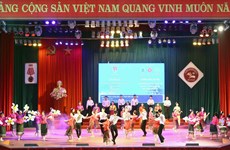Hanoi moves to control sex ratio at birth
The capital city of Hanoi is striving to better its policies on
gender equality, and intensify inspections to stop gender selection in
an effort to reduce the current high sex ratio at birth.
The capital city of Hanoi is striving to better its policies on
gender equality, and intensify inspections to stop gender selection in
an effort to reduce the current high sex ratio at birth.
According to the municipal Department of Population and Family Planning, the city’s average male-to-female sex ratio at birth remains at a high level, with 114.4 boys per 100 girls.
Eight out of the city’s 29 districts and towns report a ratio of more than 120 boys per 100 girls, which are Soc Son, Son Tay, Dan Phuong, Phuc Tho, Hoai Duc, Chuong My, Phu Xuyen and My Duc.
The rate was 116 boys per 100 girls in 2011 and 2012, and 114.5 boys per 100 girls in 2013.
The city’s Statistics Department said Hanoi is now in the period of “golden population structure”, which provides abundant human resources for local socio-economic activities. However, the structure is changing towards an “aging” tendency, with an increase in the number of the elderly and a decrease in the number of children aged under 16.
For the 2016-2020 period, Hanoi sets targets of improving population quality, maintaining a reasonably low birth rate and controlling the sex ratio at birth.
The city will invest in expanding prenatal and postnatal screening services in order to early detect congenital malformations, as well as productive health care services. Large-scale education campaigns will continue to be held to raise public awareness on family planning, gender equality and the role of females in the society’s sustainable development.
According to the head of the Department of Population and Family Planning, Ta Quang Huy, over the past four years, the capital’s population quality has been improved. Its human development index (HDI) is now higher than the country’s indicator, while the life expectancy for the city’s residents was 75 (72.6 for men and 77.6 for women) in 2013.-VNA
According to the municipal Department of Population and Family Planning, the city’s average male-to-female sex ratio at birth remains at a high level, with 114.4 boys per 100 girls.
Eight out of the city’s 29 districts and towns report a ratio of more than 120 boys per 100 girls, which are Soc Son, Son Tay, Dan Phuong, Phuc Tho, Hoai Duc, Chuong My, Phu Xuyen and My Duc.
The rate was 116 boys per 100 girls in 2011 and 2012, and 114.5 boys per 100 girls in 2013.
The city’s Statistics Department said Hanoi is now in the period of “golden population structure”, which provides abundant human resources for local socio-economic activities. However, the structure is changing towards an “aging” tendency, with an increase in the number of the elderly and a decrease in the number of children aged under 16.
For the 2016-2020 period, Hanoi sets targets of improving population quality, maintaining a reasonably low birth rate and controlling the sex ratio at birth.
The city will invest in expanding prenatal and postnatal screening services in order to early detect congenital malformations, as well as productive health care services. Large-scale education campaigns will continue to be held to raise public awareness on family planning, gender equality and the role of females in the society’s sustainable development.
According to the head of the Department of Population and Family Planning, Ta Quang Huy, over the past four years, the capital’s population quality has been improved. Its human development index (HDI) is now higher than the country’s indicator, while the life expectancy for the city’s residents was 75 (72.6 for men and 77.6 for women) in 2013.-VNA













